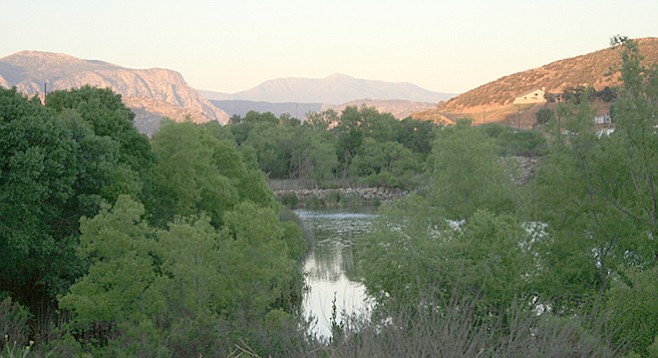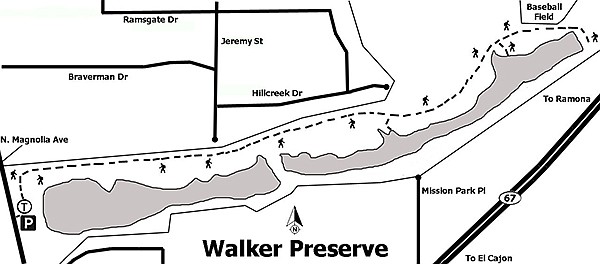 Facebook
Facebook
 X
X
 Instagram
Instagram
 TikTok
TikTok
 Youtube
Youtube

This trail adds another segment to the San Diego River Trail, which will eventually stretch 52 miles from the river headwaters in the Cuyamaca Mountains to the Pacific Ocean. The property that makes up the preserve was most recently the site of a sand-mining operation and was not open to the public. Previously, the parcel was part of the Walker family dairy farm that was in operation from 1926 until 1971.
The Walker Preserve is a 107-acre parcel that goes from Magnolia Avenue to the eastern city limits of Santee near the Lakeside Baseball Park at Marathon Parkway. East of Marathon Parkway the trail continues as part of the Lakeside River Park Trail, ending at Channel Road temporarily until the next segment is completed as it makes its way east toward the Cuyamaca Mountains. To the west, the trail continues through Mast Park with segments further west to be completed until it is a through route to the Pacific Ocean.

The Walker Preserve segment opened in April 2015. It is a 14-foot-wide trail that has a decomposed granite surface and lodge-pole fencing on both sides. Historical artifacts are present along the trail that represent the previous uses of the land. There’s a dragline dredge bucket that was once used to mine sand, as well as an original horse-drawn plow from the Walker farm. Interpretive panels describing the history and the natural features of the area are found along the trail as well as several outlooks with benches facing toward the river. The trailhead has a shaded area, picnic tables, a bicycle-repair work station, and a water fountain for dogs.
High-quality habitat is present here that is home to three bird species that are federally protected: the southwestern willow flycatcher, the California gnatcatcher, and the least Bell’s vireo. Overall, the river is home to about 25 rare and endangered species of plants and animals.
In addition to the riparian and wetland habitats along the river on the south side of the trail, there is coastal sage scrub habitat on the hillsides to the north. Willow trees, cattails, mule-fat, and other typical riparian vegetation grow near the river. Birds seen here include great blue heron, wood duck, red-winged black bird, double-crested cormorant, American coot, scrub jay, and black phoebe. Plants on the hillsides include California buckwheat, broom baccharis, white sage, coast live oak, and laurel sumac.
The Stigmella moth lays her tiny eggs between the linings of young laurel sumac (Malosma laurina) leaves. As they eat and mature, her young “leaf miner” caterpillars tunnel their way out, leaving tiny brown “waste trails” as the only evidence that they were there. Sometimes called the “taco plant,” the laurel sumac’s leaf shape helps funnel water to the roots and stems and helps prevent evaporation. The leaves are very sensitive to frost and will turn pinkish if they get too cold. To this end, some California avocado and citrus growers use this as a “sentinel plant” in their orchards. Model railroad toy sets included paint-sprayed laurel sumac blossoms as “trees.” This tree is important in chaparral habitat, providing both food and cover for a variety of birds and animals.

Distance from downtown San Diego: 20.5 miles. Allow 25 minutes driving time (Santee). Take I-8 E to SR-67 N and exit at Prospect Ave. Turn left (north) on Magnolia Ave. from Prospect Ave. and drive 1.4 miles to the trailhead for the Walker Preserve on the right. Park on the street.
Hiking length: 2.6 miles out and back.
Difficulty: Easy, flat. Equestrians, bicycles, and dogs (on leashes) allowed. Open sunrise to sunset. Facilities at the baseball park. Water.


This trail adds another segment to the San Diego River Trail, which will eventually stretch 52 miles from the river headwaters in the Cuyamaca Mountains to the Pacific Ocean. The property that makes up the preserve was most recently the site of a sand-mining operation and was not open to the public. Previously, the parcel was part of the Walker family dairy farm that was in operation from 1926 until 1971.
The Walker Preserve is a 107-acre parcel that goes from Magnolia Avenue to the eastern city limits of Santee near the Lakeside Baseball Park at Marathon Parkway. East of Marathon Parkway the trail continues as part of the Lakeside River Park Trail, ending at Channel Road temporarily until the next segment is completed as it makes its way east toward the Cuyamaca Mountains. To the west, the trail continues through Mast Park with segments further west to be completed until it is a through route to the Pacific Ocean.

The Walker Preserve segment opened in April 2015. It is a 14-foot-wide trail that has a decomposed granite surface and lodge-pole fencing on both sides. Historical artifacts are present along the trail that represent the previous uses of the land. There’s a dragline dredge bucket that was once used to mine sand, as well as an original horse-drawn plow from the Walker farm. Interpretive panels describing the history and the natural features of the area are found along the trail as well as several outlooks with benches facing toward the river. The trailhead has a shaded area, picnic tables, a bicycle-repair work station, and a water fountain for dogs.
High-quality habitat is present here that is home to three bird species that are federally protected: the southwestern willow flycatcher, the California gnatcatcher, and the least Bell’s vireo. Overall, the river is home to about 25 rare and endangered species of plants and animals.
In addition to the riparian and wetland habitats along the river on the south side of the trail, there is coastal sage scrub habitat on the hillsides to the north. Willow trees, cattails, mule-fat, and other typical riparian vegetation grow near the river. Birds seen here include great blue heron, wood duck, red-winged black bird, double-crested cormorant, American coot, scrub jay, and black phoebe. Plants on the hillsides include California buckwheat, broom baccharis, white sage, coast live oak, and laurel sumac.
The Stigmella moth lays her tiny eggs between the linings of young laurel sumac (Malosma laurina) leaves. As they eat and mature, her young “leaf miner” caterpillars tunnel their way out, leaving tiny brown “waste trails” as the only evidence that they were there. Sometimes called the “taco plant,” the laurel sumac’s leaf shape helps funnel water to the roots and stems and helps prevent evaporation. The leaves are very sensitive to frost and will turn pinkish if they get too cold. To this end, some California avocado and citrus growers use this as a “sentinel plant” in their orchards. Model railroad toy sets included paint-sprayed laurel sumac blossoms as “trees.” This tree is important in chaparral habitat, providing both food and cover for a variety of birds and animals.

Distance from downtown San Diego: 20.5 miles. Allow 25 minutes driving time (Santee). Take I-8 E to SR-67 N and exit at Prospect Ave. Turn left (north) on Magnolia Ave. from Prospect Ave. and drive 1.4 miles to the trailhead for the Walker Preserve on the right. Park on the street.
Hiking length: 2.6 miles out and back.
Difficulty: Easy, flat. Equestrians, bicycles, and dogs (on leashes) allowed. Open sunrise to sunset. Facilities at the baseball park. Water.
Comments